
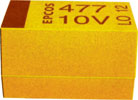
Tantalum capacitors are in great demand in automotive electronics, which imposes the toughest quality and reliability standards. For this market, Epcos has developed a new series of tantalum capacitors with extremely low failure rates.
Since 1985, the market for tantalum capacitors has been growing steadily. Customers are demanding both higher volumetric capacitance and higher quality as the number of electronic modules in automobiles keeps increasing. In today's cars, servo-assisted systems take the drudgery out of driving, while the growing number of electronic systems in general is boosting safety and convenience.
In older vehicles, sensors and electronics used to be separate. The sensors were located at the points of measurement and the evaluation electronics centrally behind the dashboard or near the passenger compartment. But today, they form a single module located right at the point of measurement. This module usually is exposed to much harsher ambient conditions here than inside the vehicle. As a result, operating conditions for passive electronic components have also become more exacting. High temperatures and steep temperature gradients in conjunction with moisture and vibrations demand the highest reliability. And as more and more electronic systems are connected straight to the car battery in low resistance circuits without a series resistor for current limiting, the components are additionally exposed to harsh external operating conditions with voltage peaks reaching 16 to 18 V.
Typical applications for tantalum capacitors include airbag controls, ABS, oil gauges and headlight controls as well as remote keyless entry, engine management and navigation systems. All these electronic systems must operate with absolute reliability because they are vital to safety functions.
Automotive electronics
Epcos responded to these demands of the automobile industry years ago by introducing special capacitors of the 'Performance series'. They are distinguished by high long-term stability, low failure rates, an operating temperature range up to 150°C and the ability to operate without a series resistor (Table 1).
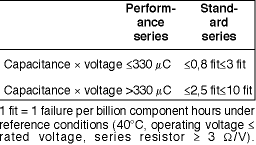
The outstanding properties of the Performance series are achieved by means of a unique design and special production processes. For instance, when the dielectric layer is deposited by anodic oxidation of the tantalum, a higher voltage is used than for capacitors of the standard series. This leads to a thicker oxide layer which is much more resistant to breakdowns. However, if the thickness of the dielectric layer (d) is increased, the tantalum powder grains must also have a greater surface area (A) to keep the capacitance of the capacitor constant. This means increased consumption of cost-intensive tantalum powder.

Tantalums for up to 175°C
Progressive encapsulation and miniaturisation of the engine compartment and the higher integration density resulting expose components close to the engine to higher thermal loads. New materials must be used to ensure reliability at temperatures up to 175°C as well. Manufacturers of active and passive electronic components are working jointly on this task within the scope of an EU project known as PROCURE. In tantalum capacitors, the conductive resist layer of the capacitor element and the cement bond between this element and the terminals proved particularly critical at high temperatures (Figure 1).
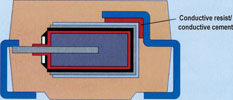
In cooperation with suppliers, new materials were developed that assure stable electrical properties in the capacitors at temperatures up to 175°C (Figure 2). These capacitors make up the T series recently introduced.
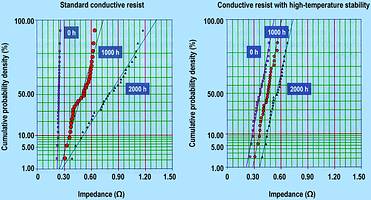
Recent legislation has made it necessary to replace the material containing lead used for the terminals of tantalum capacitors by 100% lead-free material. Apart from legal requirements, this change yields benefits for the soldered joints. The higher melting point of the lead-free solder pastes makes the soldered connection more stable so it can be used at temperatures up to 175°C. However, the components are likewise exposed to greater thermal stress during soldering. Tantalum capacitors have proved very resistant to higher soldering temperatures up to a maximum of 260°C. So from a technical standpoint, it was merely necessary to adapt the process parameters to lead-free system carriers.
Infotainment requirements
More and more information and entertainment systems are finding their way into motor vehicles. This means that requirements common in the telecommunications industry are now being applied to the automotive sector. Higher capacitance and smaller packages in conjunction with extremely low impedance or equivalent series resistance (ESR) are typical requirements for tantalum capacitors. The only way to reduce impedance or ESR is to replace the manganese dioxide used for conventional cathodes by highly conductive polymers.
Cooperation across the board
Tougher requirements for all automotive components means that suppliers at all levels will have to cooperate even more closely. This is particularly true of the 42 V automotive electrical system of the future, which will present suppliers throughout the industry with new challenges.
Profile: Tantalum capacitors
Tantalum capacitors feature highest volumetric capacitance. They are mainly used as support capacitors where space is restricted. Multi-anode and polymer technologies ensure particularly low ESR, which has been reduced by a whole order of magnitude. Epcos is one of the world's leading manufacturers of tantalum capacitors.
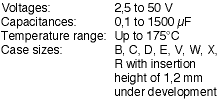
| Tel: | +27 11 458 9000 |
| Email: | [email protected] |
| www: | www.electrocomp.co.za |
| Articles: | More information and articles about Electrocomp |

© Technews Publishing (Pty) Ltd | All Rights Reserved